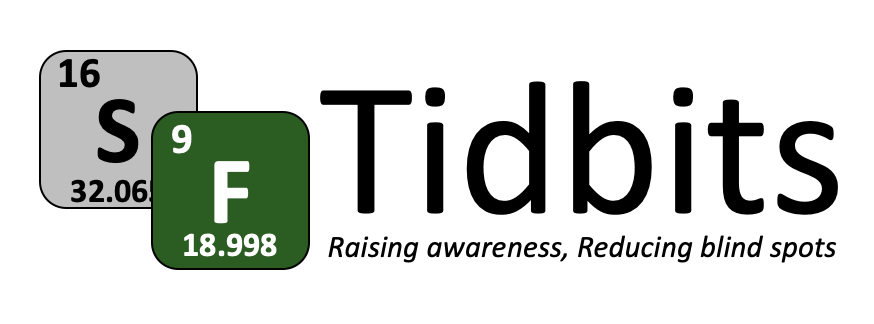I Bonds
5/13/25
I Bonds are U.S. Treasury savings bonds. They are a low-risk investment option designed to protect against inflation. I Bonds offer a fixed interest rate that is combined with an inflation rate component, which is adjusted every six months based on changes in the Consumer Price Index (CPI). This means that your investment keeps pace with inflation. They can be purchased from the U.S. Treasury in electronic form up to $10k/person/year. I Bonds are considered a safe and inflation-protected addition to a diversified investment portfolio.
I Bonds aren’t designed for significant growth, but rather to hedge against inflation.
Statement of Income and Expenses
5/6/25
A statement of income and expenses is a financial report to evaluate the financial performance of a business, organization, or individual over a specific period of time, typically a month, quarter, or year. On a personal basis it shows inflows and outflows and can help you understand where your money goes. A statement of income and expense can be powerful to 1) help you meet future goals, 2) ensure your spending aligns with your values.
Auto Policy Coverage
4/29/25
Nearly all of us have auto insurance, but not all of us understand it.
Uninsured or Under-Insured covers damages in case the party responsible does not have insurance or enough insurance. It also covers hit-and-run accidents. A 2021 study by the Insurance Research council estimated 13% of US drivers are uninsured.
Collision pays for damage to your own vehicle caused by a collision, regardless of fault.
Comprehensive covers damage to your vehicle from non-collision incidents, such as theft, vandalism, hail or natural disasters.
Collision and comprehensive insurance are often dropped on older vehicles. If your current vehicle were significantly damaged, would you repair or replace? Is your insurance consistent with that answer?
Roth Ladders
4/22/25
A Roth ladder is an early retirement funding technique to create future cash flows without incurring early withdrawal penalties. Pre-tax money can be converted to Roth funds by paying income taxes in the current year. However, Roth conversions can’t be accessed for 5 years after conversion. By Year 6 one can have a sustainable process to convert $100k and pay taxes on it while accessing a different $100k of tax-free money from the Roth IRA.
Planning is necessary to develop a strategy to support the first 5 years. There are many options but taxable investments, savings, current income, Roth contributions, Mega-backdoor Roth contributions and a Health Savings Account can all help. Roth ladders are a popular option for those who choose to retire at a very early age.

Restricted Stock Units
4/15/25
Restricted Stock Units (RSUs) are a common form of employee compensation, often targeting higher level employees. RSU plans are designed to increase retention by providing stock to employees. However, this “restricted” stock typically vests over several years. If the employee leaves the company, any unvested shares are forfeited.
At receipt of restricted stock, there are no tax implications since there is a risk of forfeiture. W-2 income will be recognized after shares are vested and available to the employee.
Employees with RSUs should consider portfolio risks associated with a concentrated position in a single company. It is commonly recommended to sell company stock and diversify with the proceeds.
Market Strategies Don’t Work
4/8/25
What trading strategies beat the market? None of them (today). Several trading strategies have worked in the past – dogs of the Dow, year-end or ex-dividend data trading, etc. However, once a successful trading strategy is identified, the market will adjust, and the strategy will cease working. It’s self-defeating once publicly known.
If a $1 stock movement can be expected in the future, investors will purchase that stock today, driving the price up. The price will continue to increase until it is no longer expected to produce a higher return than other options. Any known market inefficiency is quickly arbitraged in today’s computer age.
Rule of 55
4/1/25

The rule of 55 is an IRS provision that facilitates early retirement and allows for companies to offer early retirement packages. If you turn 55 during the calendar year you lose or leave your job, you can begin taking distributions from your recent employer’s retirement plan without paying the 10% early withdrawal penalty. This only applies to the recent employer’s plan – 401(k), 403(a), 403(b). This early access benefit is forfeited if funds are rolled over to an IRA. Funds in IRAs generally cannot be accessed penalty-free before age 59 ½. Although the rule of 55 is allowed by the IRS, it’s still important to verify your employer’s plan allows for these withdrawals.
Is My Inheritance Taxable?
3/25/25
Is my inheritance taxable? Inherited property is not taxable at the federal level. All federal estate taxes, if applicable, are paid by the estate of the deceased before distribution to heirs. Estate taxes are relatively rare, impacting about 0.1% of estates due to high exemption levels (2025: $13,990,000 for an individual; $27.98 million for a married couple). The probate process ensures that all creditor claims are settled before property is distributed to heirs, so any inherited property is owned outright by the heir.
Exceptions are traditional IRAs or pre-tax 401(k) retirement accounts. These previously untaxed assets are classified as “income in respect of decedent”. Withdrawals will be recognized as taxable income by the beneficiary.
Currently six states (NE, IA, KY, PA, NJ, MD) have a state level inheritance tax with varying rules.
Employee Stock Purchase Programs
3/18/25
Employee Stock Purchase Programs (ESPP) allow employees to buy company stock at discounted prices, often 15% below market value. Many of these plans utilize a lookback period that sets the purchase price to the lower price at the beginning or end of the offering period. Plans may or may not have a minimum holding period.
ESPPs can be viewed as a portion of employee compensation. They often provide valuable benefits to employees and should be strongly considered.
Dow employees not taking advantage of their ESPP can schedule a free chat with Scientific Financial. Dow’s offering is very attractive.
Behavioral Finance Biases – Herding
3/11/25
Behavioral finance bias refers to how psychological biases influence financial decisions. One common behavioral finance bias is herding. People tend to follow the masses or the “herd”. People tend to get optimistic or pessimistic about the stock market at the same time. The same can happen with individual stocks driving a stock to an unsustainable valuation. Jumping on the bandwagon often leads to longer term disappointment when markets return to balance. The herd has a tendency to get greedy and invest more as prices go up. The herd experiences fear and sells when prices fall. Buying high and selling low is not a great strategy. Generally, staying the course works better than following the latest investing trends.
Deductions vs Credits
3/4/25
Deductions reduce your taxable income, which in turn lowers your overall tax liability. Credits, on the other hand, directly reduce the amount of taxes you owe. Both deductions and credits can significantly impact your tax situation. While deductions vary based on eligible expenses, credits provide more direct tax relief.
For a 25% marginal rate, a $4 deduction would reduce tax liability by $1. A $1 credit also reduces tax liability by $1.
The Experts Aren’t Experts
2/25/25
Do you wish you could invest like the experts on TV? I don’t. Those “experts” are just entertainers. Consider Jim Cramer – Host of CNBC’s Mad Money. A 2018 Wharton School study found his Action Alerts PLUS portfolio returned 4.1% annually vs the S&P 500’s 7.1%.
Cramer’s results were so bad that an Inverse Cramer Tracker ETF was created that “seeks to provide investments results that are opposite of recommendations by television personality Jim Cramer.” Wow!

Account Tax Status Matters
2/18/25
Many investors focus on choosing the right investments but neglect choosing the right accounts. The tax treatment of an account plays a major role in maximizing returns. Below is the 30-year balance on a hypothetical $1 pre-tax investment with a yearly return of 8%.
The tax nature of a Health Savings Account leads to a dramatically larger post-tax balance vs other investment accounts. Pre-tax 401(k)s and Roth IRAs are nearly identical in their tax liability. Brokerage accounts are not tax advantaged (but provide flexibility), and those increased taxes reduce post-tax returns.
It’s not just what you invest in. It’s how you invest in it.

Options: Calls and Puts
2/11/25
Options are not appropriate for most investors. They’re essentially side bets in financial markets. Unlike investing, options are a zero-sum game – every winner is matched to a loser.
Call Option: This gives the holder the right (but not the obligation) to buy a specific asset at a predetermined price within a set time frame.
Put Option: This gives the holder the right (but not the obligation) to sell a specific asset at a predetermined price within a set time frame.
Assume an employee is granted $300k of ABC stock but must hold it for 6 months. This results in substantial portfolio risk. The employee could reduce risk by buying a put option. If ABC stock goes up, the employee will not exercise the option and can sell the appreciated stock in 6 months. If ABC stock goes down, the employee can exercise the option and sell ABC stock in 6 months at the higher pre-determined price. For the fee of purchasing the put option, the employee guaranteed they could sell ABC stock for at least the option’s predetermined price. It’s insurance, not investing.
Tax Status of Investment Accounts
2/4/25
Investment accounts can have different tax status. These differences introduce strategic investment location opportunities. For example, Roth IRAs are well-suited to hold stocks since future gains are untaxed. Traditional IRAs and pre-tax 401(k) are well-suited to hold bonds since these accounts have the highest future tax liability. Roths can be favored in low-income years while pre-tax accounts may be favored in high-income years. Understanding the tax code and account tax status is the best way to reduce lifetime taxation and maximize your post-tax returns.

Many don’t consider a Health Savings Account for investment opportunities. However, when utilized as an additional retirement account it becomes the most tax-efficient account available.
Value of a Financial Advisor
1/28/25
A financial advisor can provide valuable financial guidance. They offer insights into optimizing investments, reducing taxes, managing risk, and creating tailored financial strategies. Advisors can help align financial goals with your unique circumstances, ensuring you’re aware of opportunities and potential pitfalls. While they can’t predict market outcomes, their expertise helps in making informed decisions. Engaging with a qualified advisor can lead to a clearer financial path, enhancing your ability to achieve both short-term and long-term objectives.
Terms like fee-only, fiduciary, advice-only, independent, CFP® may be important considerations in selecting a financial advisor. You can interview multiple financial advisors for free. You’re in charge!
What is a CD?
1/21/25
A Certificate of Deposit (CD) is a financial instrument where you deposit a fixed sum of money with a bank or credit union for a predetermined period, typically ranging from a few months to several years. In return, you receive a fixed interest rate that is generally higher than regular savings accounts. CDs are a low-risk, interest-bearing investment option. It’s essential to be aware of the CD’s maturity date because withdrawing funds before maturity may result in penalties. CDs may supplement the bond portion of a portfolio and provide additional diversification.
CDs are sometime used for near term, planned purchases (house down payment, college tuition, etc.) Investors can use CDs to lock in a rate and ensure they have a known amount of cash when an expense is due.
Are Gifts Taxable?
1/14/25
Are gifts taxable? Gifts received are not taxed. Gifts given are not taxed in the vast majority of cases. However, there are specific rules and limits regarding gift taxes to prevent exploitation of the estate tax system. If an individual gives a gift above the annual exclusion limit ($19,000 in 2025; $38,000 per married couple), they may need to file a gift tax return. However, gift tax is usually not owed until the lifetime gift exclusion limit is exceeded ($13.99 million per person in 2025).
Takeaway: Gifts taxes are a nonissue for most families. Gift taxes only apply to a donor who has made very large gifts.
Stock Splits
1/7/25
Stock splits are corporate actions where a company divides its existing shares into multiple new shares. It’s a strategic move, typically done to make the stock more affordable for a broader range of investors. For example, in a 2-for-1 split, each existing share is divided into two new shares, effectively halving the stock’s price.
A reverse stock split is the opposite of a regular stock split. For example, in a 1-for-5 reverse stock split, every five existing shares become one new share.
Although market responses can be fickle, value isn’t created or destroyed by stock splits. It’s just a simple mathematical maneuver to partition stock into packages of a desired size.
Treasury STRIPS
12/31/24
Treasury STRIPS, or Separate Trading of Registered Interest and Principal Securities, are secondary financial instruments. Financial institutions create STRIPS by “stripping” or separating the interest payments and principal of a Treasury note/bond and selling them as individual securities. STRIPS allow investors to purchase and trade specific components of a Treasury bond. They are typically bought at a discount and pay no periodic interest but provide a fixed return at maturity. STRIPS have a low-risk nature due to government backing of U.S Treasury notes/bonds.
Example: A 7-Year U.S. Treasury note yielding 4% has 14 semi-annual payments and a return of principle. These 15 cash flows are sold individually as STRIPS. An investor may not want the regular cash flow of a 7-Year U.S. Treasury note. That investor can purchase a STRIP to only receive the semi-annual payment due in 6.5 years.
Darkest Before the Dawn
12/24/24
Markets drop and that’s scary. However, it’s generally best to stay invested. It’s often darkest before the dawn. The graphic below from Factset shows just how impactful missing the best market days can be. Many of those best market days occur soon after the scariest market days. Investors are often best served by staying the course.
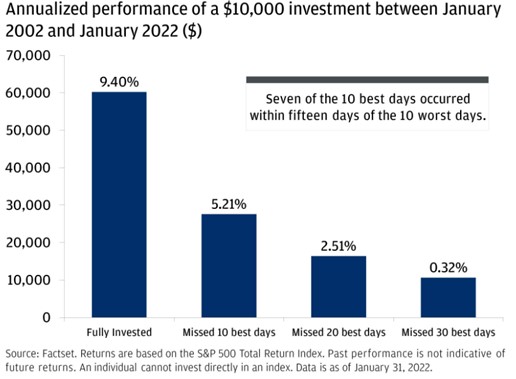
Emergency Fund
12/17/24
An emergency fund is a financial safety net. It’s a savings buffer designed to cover unexpected expenses, such as medical bills, car repairs, job loss, or other unforeseen emergencies. This fund provides peace of mind and prevents the need to rely on credit cards or loans during crises. Typically, it’s recommended to have three to six months’ worth of non-discretionary living expenses saved in your emergency fund. This prudent practice safeguards your financial stability and allows you to address challenges without derailing your long-term financial plans.
Medicare
12/10/24
Medicare is a federally funded health insurance program in the United States primarily designed for individuals aged 65 and older. Original Medicare is divided into 3 different parts:
- Part A: Hospital Insurance – Covers inpatient hospital stays, skilled nursing facility care, hospice care, and some home health care.
- Part B: Medical Insurance – Covers outpatient care, doctor visits, preventive services, and some home health care services.
- Part D: Optional Prescription Drug Coverage – Provides prescription drug coverage through private insurance plans.
Part A typically has no premium. Parts B and D have premiums that may vary with income. Medicare has a unique set of co-pays and other terms.
Why You Shouldn’t Pick Individual Stocks
12/3/24
Choosing individual stocks can be risky, and there are several reasons why many investors opt for other investment strategies. Those reasons include lack of diversification, market volatility, time-consuming, limited information relative to institutional investors, and emotional bias.
Nobel prize winner Harry Markowitz developed modern portfolio theory. His efficient frontier theory explains why a relatively small basket of individual stocks should be expected to have sub-optimal returns. More diversified approaches using indexes or target date funds are expected to yield higher returns for a similar risk profile.
Why Tax Loss Harvesting Isn’t as Good as It Seems
11/26/24
Tax Loss Harvesting may generate a lot of buzz, but its benefits are often exaggerated. Tax loss harvesting is a strategy used in investment management to minimize capital gains taxes by selling investments that have experienced losses.
Tax loss harvesting creates lots and lots of complexity, requiring significant time (aka cost) in properly maintaining the strategy. This may be worthwhile for multi-million-dollar taxable portfolios, but not for the vast majority of American families.
Most investors have the majority of their assets in tax-advantaged accounts (401(k), 457, Roth IRA, 529, HSA, etc.). These accounts don’t have capital gains taxes to avoid.
Tax loss harvesting primarily benefits investment managers. Once the strategy has been adopted, the investor has 2 choices: remain reliant on the advisor to manage the strategy or pay significant taxes to abandon the strategy. Think twice before adopting this strategy.
Balance Sheet
11/19/24
A balance sheet is a financial statement to assess the financial health and position of a company, organization, or individual. It provides a snapshot of the assets, liabilities, and equity at a specific point in time. Relating to personal finance, Assets – Liabilities = Net Worth.
A personal balance sheet can provide a clear understanding of your financial picture, including the value of possessions, the extent of debts, and overall net worth. Analyzing a personal balance sheet can guide financial planning, decision-making, and goal setting.
Taking Social Security at 62 vs 67 vs 70
11/12/24
Social Security is a government program that provides financial support to individuals who are retired, disabled, or survivors of deceased workers. Payments are adjusted for inflation each year and continue throughout a retiree’s lifetime.
Retirees can choose to begin withdrawals between age 62 and 70. Earlier withdrawals result in a lower payment but more lifetime payments. Later withdrawals result in higher payments but fewer lifetime payments. The breakeven points are near average life expectancies. The best option will vary by individual and is often dictated by health and financial situation.
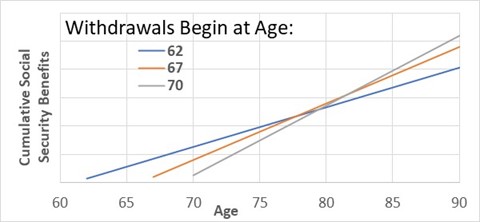
Wills, Executor and Guardianship
11/5/24
Wills are crucial legal documents that specify how some assets and possessions will be distributed after one’s passing. Wills do not control distribution of all assets. Bank accounts, investment accounts, houses, cars, etc. may have transfer on death (TOD) titling or have beneficiary designations. These assignments supersede the will and bypass probate. Probate is the legal process through which the court validates and administers a deceased person’s will. Wills are designed to transfer other assets and the remainder of the estate.
Wills should name an executor. The executor’s role is to document all assets, handle outstanding debts/taxes, navigate the probate process and legal issues, and assist with distributing assets after probate. The executor closes all the loose ends on behalf of the deceased.
Wills are also very important to assign guardianship of minor children. It’s much better for you to choose a guardian than a court on your behalf. A court may be forced to choose the closest relative, rather than the best environment for your children.
Types of Annuities
10/29/24
Annuities are a commonly misunderstood and often overhyped financial product. Types include fixed, variable, immediate, deferred, indexed, and longevity annuities. Although annuities generally have high expenses, commissions, surrender fees, and critically important details, annuities can be a good option for some families. Unfortunately, the typical complexity and nuance in annuities is beyond the average investor’s knowledge and many make poor annuity decisions. It’s best to discuss these complex products with a knowledgeable financial advisor who won’t be compensated based on your decision.
Social Security Payment Formula
10/22/24
The social security payment formula is complex but worth understanding. The Social Security Administration considers your 35 highest-earning years (inflation adjusted) to determine an average indexed monthly earning (AIME). It then applies a regressive benefit formula to determine your primary insurance amount (PIA). The PIA is the amount you’ll receive but will vary based on what age you choose to begin drawing Social Security.
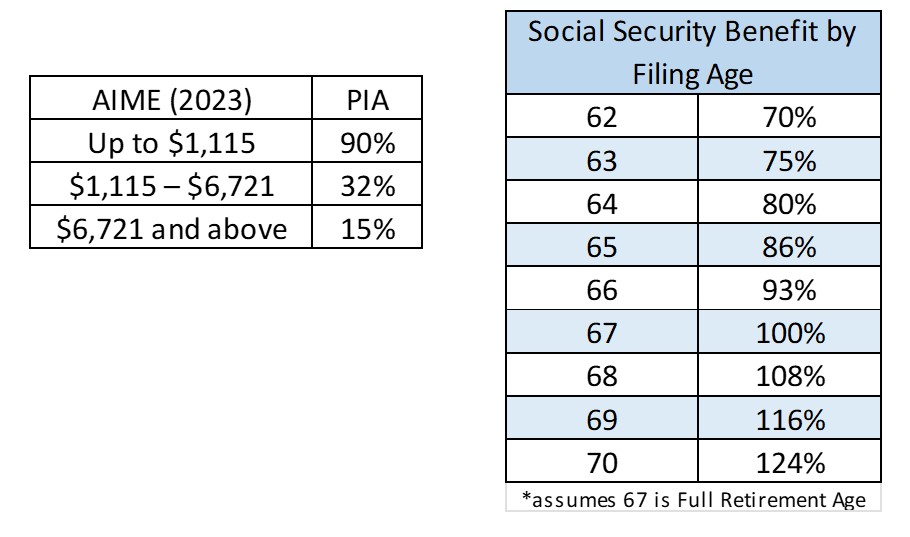
There’s more nuance to the calculation but that’s the 95% summary. Some high wage earners may realize that retiring earlier may have a minimal impact on social security benefits.
College Costs
10/15/24
It’s commonly recognized that college costs are increasing at an alarming pace. But is this true? College costs did rise rapidly in past decades (for specific reasons unlikely to repeat), but that’s not the case today. The Money Education textbook for CFP® coursework includes this startling trend. Over the last decade college prices increased in line with inflation.
FYI, I was skeptical and did some digging. My spot checks agreed with the textbook. If you’re skeptical, check historical prices yourself.
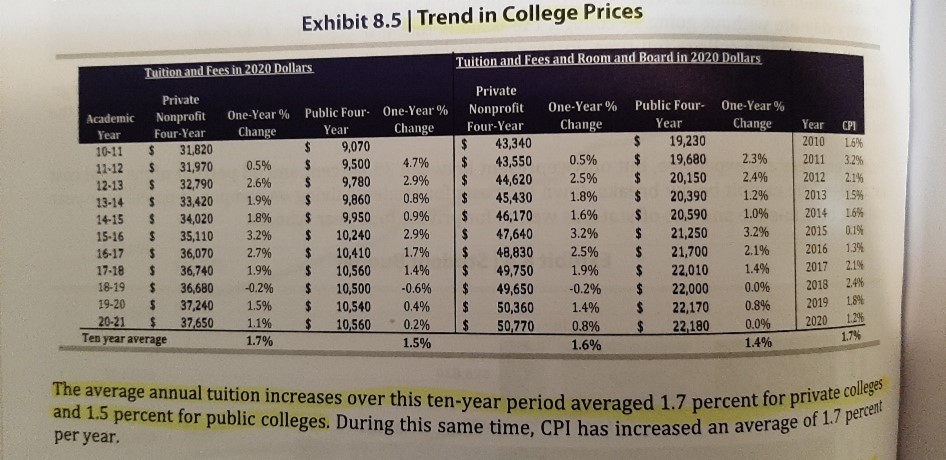
Estate Taxes
10/8/24
Estate taxes may be imposed on the transfer of assets upon someone’s death. Many assume these taxes impact typical families, but federal estate taxes only impact about 0.1% of U.S. families. 99.9% of families do not pay these taxes. Federal estate taxes only apply to asset values over the exemption limits. In 2024, the federal estate tax exemption is $13,610,000 for an individual or $25,840,000 for a married couple. In addition, there are numerous estate planning strategies to avoid or reduce estate taxes for families with assets above $27.22 million.
State estate taxes vary by state. Most states have no estate taxes (including TX & MI). Twelve states impose estate taxes with varying tax rates and exemption levels.
Impact of a 1% Fee
10/1/24
Recent research has shown that many investors underperform the market by 2-3% due to high fee fund selection, excessive trading, exiting to cash, etc. Many investors don’t consider a 1% fee significant, but a 1% fee historically can result in a 24% reduction over 30 years. Compounding is powerful. Inefficiencies and fees matter!
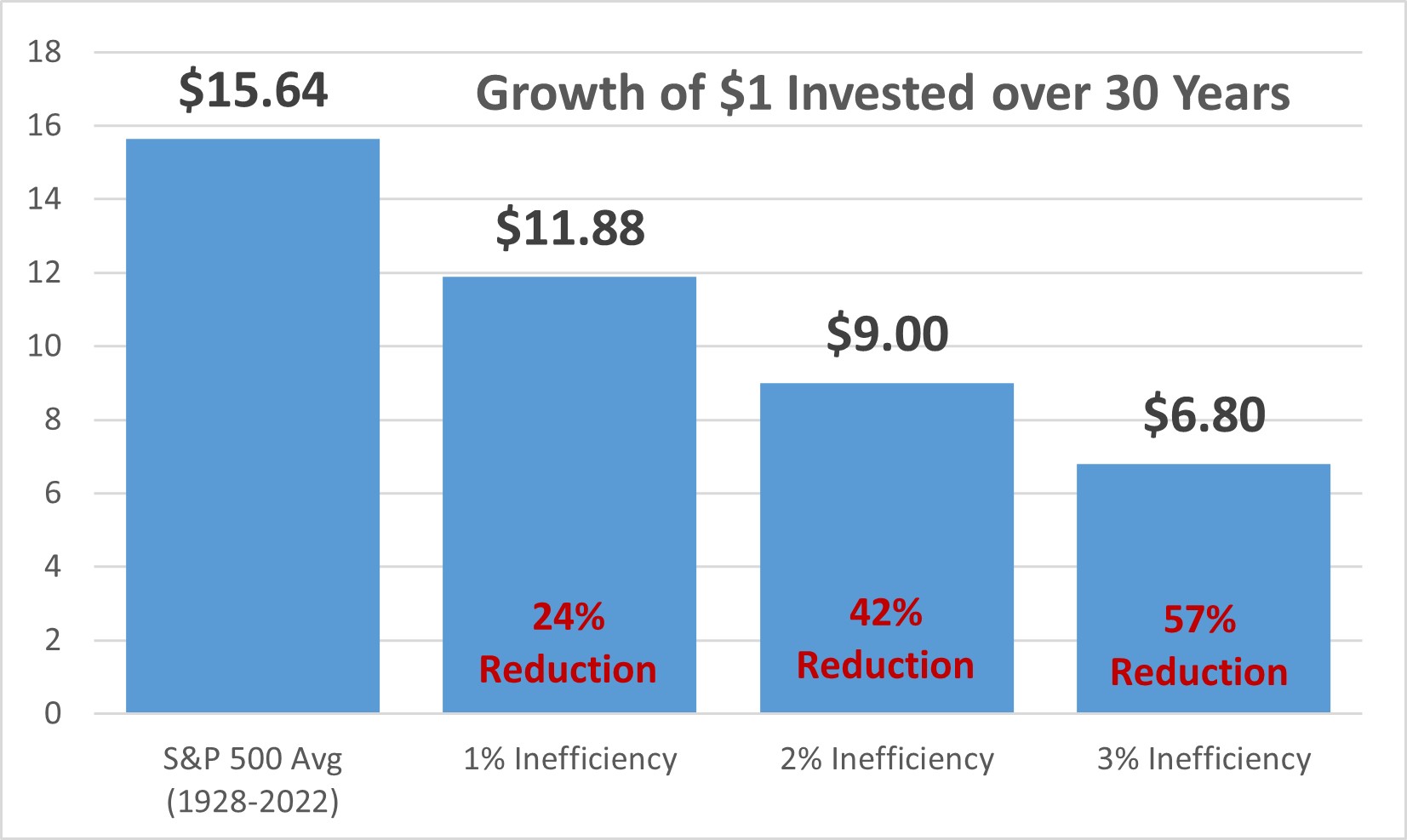
The Stock Market Doesn’t Care Who’s President
9/24/24
Some voters think that the stock market performs better under one political party than the other. Over the last 100 years the stock market has done better under Democrats, but that does not imply cause and effect. Macro-economic events play a much larger role than who sits in the White House. The stock market soared under Bill Clinton (+210%: the internet) and lost ground under George W. Bush (-40%: dot com bust, 9/11, housing crash). Barack Obama (+182%) benefited from the housing recovery, and the market has continued to grow under Donald Trump (+63%) and Joe Biden.
The stock market doesn’t seem to care who’s President.
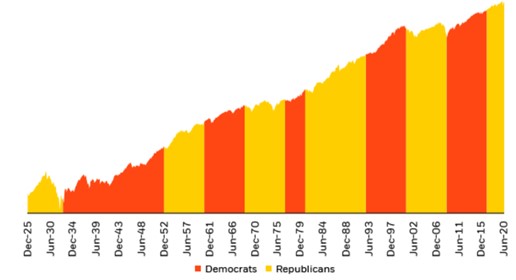
![]()
Advantages of an Advice-Only Advisor
9/17/24
An advice-only financial advisor can offer several advantages for investors seeking guidance:
- Objective Advice
- Transparent Fees
- Flexibility
- No Product Sales Pressure
- Maintain Control over your Assets
Unlike most financial advisors, advice-only financial advisors don’t receive reduced compensation when you pay down your mortgage, buy real estate, invest in a business, avoid a particular fund or financial product, keep retirement funds in an employer plan, or spend money enjoying your life! The advice-only model allows for transparent, conflict-free advice providing you with the best advice for your situation. You also maintain 100% control of your assets.
Present Value vs Future Value
9/10/24
Present value refers to the value of an asset today or the value of a future asset discounted to today accounting for the time value of money. Future value represents the value of an investment at a specified point in the future, considering compound interest or growth.
$100 today has much higher purchasing power than $100 will have in 2050. It isn’t always apparent whether an amount of money has a high or a low purchasing power far into the future. Financial planning software, such as eMoney and Income Lab, can toggle between present and future values to help you better understand your financial plan and purchasing power.
US and International Stock
9/3/24
U.S. stocks refer to shares of companies based in the United States, while international stocks are from companies located outside the U.S. Investing in both can provide diversification benefits.
Recently U.S. stocks have outperformed international stocks, but this isn’t always the case. Financial markets are balanced. Prices in attractive markets will rise until they become unattractive. Prices in unattractive markets will drop until they become attractive. No one knows the future with certainty, and no one knows whether domestic or international stocks will outperform in the future. Most investors benefit from having a broad-based, low-cost, diversified portfolio. Inclusion of international stocks can help diversify your portfolio.
Homeowner’s Insurance
8/27/24
Homeowners insurance provides protection for your home. It offers coverage against various risks that can damage the property or lead to financial liabilities. You may think it only covers your home, but it typically also covers most personal property inside the home, liability coverage, temporary housing expenses, and medical payments.
Homeowners insurance is a tool to mitigate financial risks associated with property ownership. Lenders often require it as a condition of getting a mortgage. It’s not uncommon for policy costs to vary by insurer so it’s a good practice to shop around from time to time.
Stocks are a Good Hedge for Inflation
8/20/24
Stocks are often overlooked as a hedge against inflation. Stocks have historically outpaced inflation rates over the long term.
Let’s take a step back and consider inflation. Inflation is when the price of goods increases. Companies that sell these products receive higher revenues for the same products. Although these companies may have higher raw material costs, they’re often able to pass increased costs to the consumer. Companies typically maintain similar profit margins over the long term. Inflation typically leads to higher long-term profits for companies, and this is generally reflected in their stock price.
A Random Walk Down Wall Street
8/13/24
“A Random Walk Down Wall Street” by Burton G. Malkiel is an incredible book to teach investors exactly how investing works. It addresses historical bubbles, current philosophies, time-tested strategies, and much more. It exposes the financial industry’s BS and propaganda with data. Although not a casual read at 400+ pages of fairly technical content, I’m aware of no better book to recommend to those who want to understand the stock market and improve their investing efficiency. This book is worth its weight in gold.
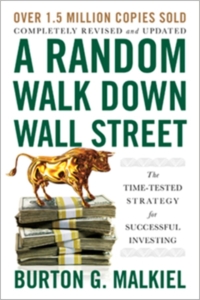
Asset Allocation
8/6/24
Asset allocation involves distributing an investment portfolio among various asset classes, such as stocks, bonds, and cash, to balance risk and potential return. The goal is to create a diversified portfolio that aligns with your goals, risk tolerance, and time horizon. A proper asset allocation strategy allows you to weather market fluctuations and achieve long-term financial objectives.
ABLE Accounts
7/30/24
ABLE accounts, formally known as “Achieving a Better Life Experience” accounts, are a financial tool designed to help individuals with disabilities and their families save money for disability-related expenses. These tax-advantaged savings accounts can be used to cover costs such as education, housing, transportation, and healthcare.
ABLE accounts are similar to 529 accounts. 529s cover college expenses in a tax-advantaged way. ABLE accounts cover expenses for disabled persons in a tax-advantaged way.
Eligibility criteria and rules vary by state. Research appropriately or contact a financial advisor if ABLE accounts may benefit your family.
Alpha
7/23/24
Alpha is an investing term used to quantify investing performance. Alpha is the difference between the actual return on a portfolio and its expected return as outlined by the capital asset pricing model.
Alpha does not refer to over-performance over a benchmark since this does not consider the riskiness of the investment (Beta). Alpha is quantified on a risk-adjusted basis and is widely accepted as the proper measure of an investment’s over/under performance.
What is a Trust?
7/16/24
A trust is a legal entity that holds and manages assets on behalf of beneficiaries. It allows individuals to transfer assets to the trust, with specific instructions on how those assets should be managed and distributed. Trusts can serve various purposes, including estate planning, asset protection, and providing for loved ones. Trusts can offer benefits like avoiding probate, minimizing taxes, and controlling how assets are used in the future.
How Much Can I Contribute to Tax Advantaged Accounts?
7/9/24
How much can I contribute to tax-advantaged accounts in 2024? There are several tax-advantaged accounts including:
- 401(k): $23,000 pre-tax, but $69,000 to the entire 401(k). The difference can include after-tax contributions that can potentially be rolled to a Roth IRA. For dual income families, these values apply to each spouse individually.
- Health Savings Account: $4,150 individuals; $8,300 families. This is a great one and a high priority to fund since it can completely avoid all taxation and can typically be invested in stocks. Strategically, it’s more of a super-advantaged retirement account than a health reimbursement account.
- Roth IRA: $7,000 with potential income restrictions and workarounds
- Dependent Care Flexible Spending Account: $5,000. This is a tax-efficient way to pay for a child’s daycare.
Participation in these programs can dramatically reduce your taxes. Some allow larger contributions for those aged 50+.
Historical Market Returns
7/2/24
Historical market returns are important to ensure investors have reasonable expectations of the future. The S&P 500 (a common gauge of the US stock market) returned an average compounded return of 9.6% from 1928 through 2022, including dividends. However, stock returns can vary dramatically from one year to the next. The plot below shows the frequency of returns. The S&P 500 has had approximately 3 positive years for every down year.
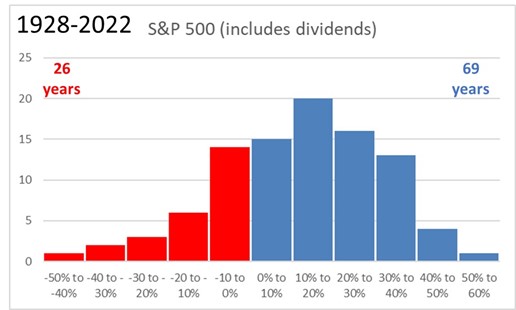
Recency Bias
6/25/24
Behavioral finance bias refers to how psychological biases influence financial decisions. One common behavioral finance bias is recency bias. If a particular stock (consider NVIDIA or meme stocks) has been performing well over the last few weeks or months, someone affected by recency bias might assume that the trend will continue and make investment decisions accordingly, without taking into account other relevant factors. To counter recency bias, it’s important to adopt a more comprehensive and balanced approach to decision-making. It’s best to consider historical data, long-term trends, and fundamental factors that drive financial markets, rather than being swayed solely by recent trends.
Beta
6/18/24
Beta is a measure of a stock or investment portfolio’s sensitivity to market movements. It helps assess the investment’s risk in relation to the broader market.
Beta is expressed as a numeric value. A beta of 1 indicates that the investment tends to move in line with the market. A beta greater than 1 suggests the investment is more volatile than the market, while a beta less than 1 implies lower volatility. If a stock has a beta of 1.2, it’s expected to be 20% more volatile than the market. Conversely, a stock with a beta of 0.8 should be 20% less volatile. High-beta stocks are riskier but may offer higher returns, while low-beta stocks are less risky but may have lower returns.
Beta has limitations, as it only considers historical price movements and doesn’t capture all types of risk, such as company-specific events.
Target Date Funds
6/11/24
Target date funds have become very popular in retirement plans, and rightfully so. They often provide maximum diversification and convenience. Investors can simply choose the one with a name closest to their expected retirement date and obtain an entire investment portfolio in a single fund.
While target date funds have drawbacks, particularly around tax efficiency, they provide a solid portfolio for a typical investor. Fund design varies among the brokerages, but they typically have common qualities: use of the broadest, low-cost funds; proportional US/international stock exposure; high stock allocation in early years shifting to a more conservative portfolio over time.
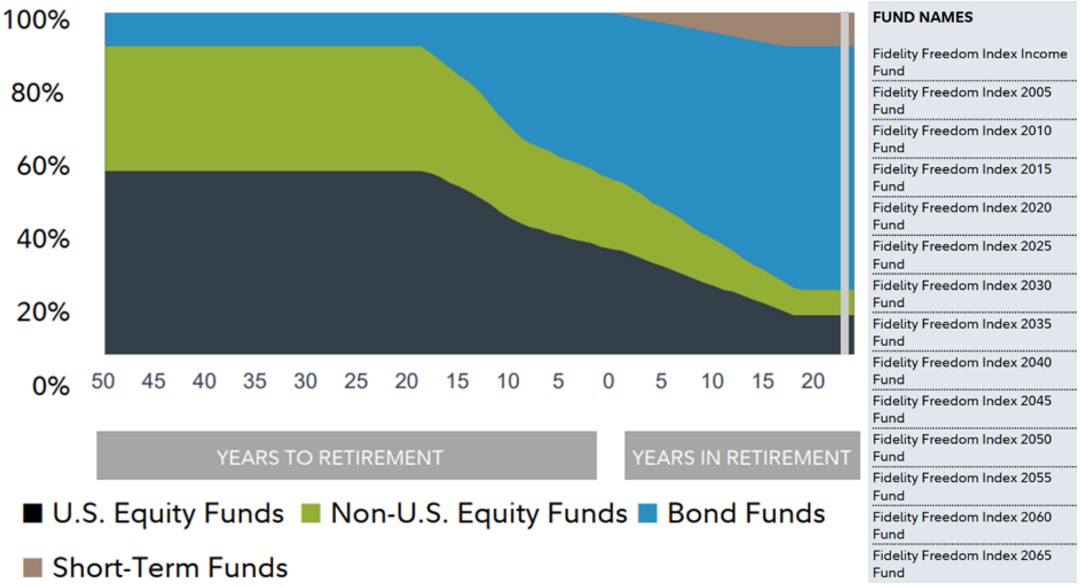
Auto Policy Coverage
6/4/24
Nearly all of us have auto insurance, but not all of us understand it. Liability covers costs if you’re responsible for an accident, including medical bills and property damage for the other party. You may be responsible for damage beyond these limits.
A split policy may have 3 numbers: 30k/60k/25k (Texas min coverage)
- $30k of coverage for injuries per person
- $60k of coverage for injuries per accident
- $25k of coverage for property damage
A combined policy has 1 number which combines all bodily injury and property damage.
Consider the cost of medical treatment and the costs of new vehicles today. Then decide whether your liability coverage is appropriate.
Tactical Asset Allocation
5/28/24
Tactical asset allocation is an active management portfolio strategy that shifts the percentage of assets held in various categories to take advantage of market pricing anomalies or strong market sectors. Example: an investor or fund may over/underweight portions of the portfolio if they think tech stocks will overperform or energy stocks will underperform in the future.
But can one effectively predict future under/overperforming segments to make this strategy work? According to Morningstar’s research, tactical allocation strategies haven’t worked well in the past with 52 of 52 tactical allocation funds underperforming over 10 years.
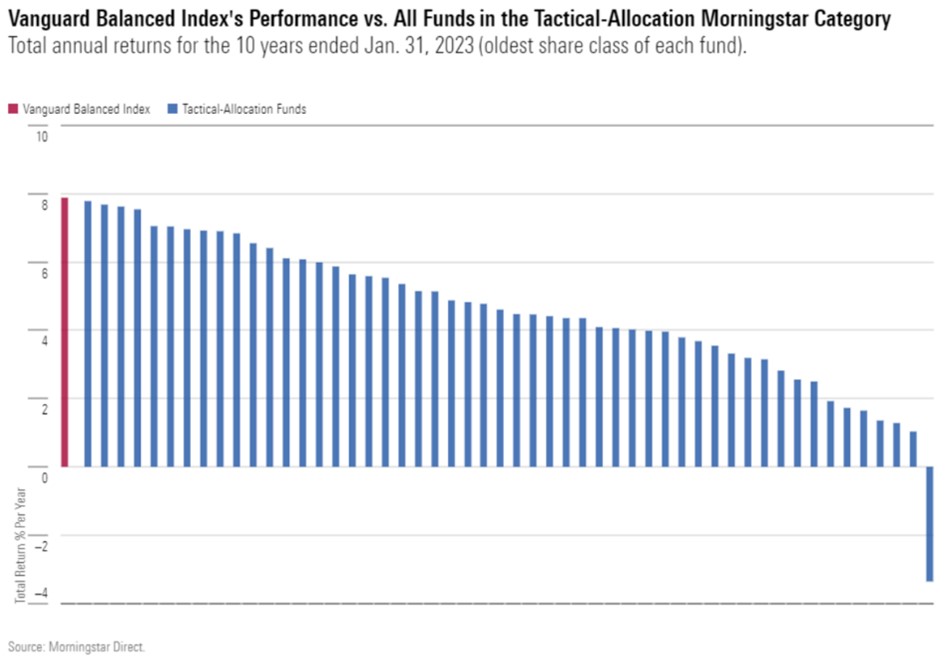
Bond Funds vs Individual Bonds
5/21/24
Most investors opt to own bond funds rather than individual bonds. A bond fund is a diversified collection of individual bonds, often with varying yields and duration. These funds use the generated revenue to purchase additional short, medium, or long-term bonds and generally maintain the bond profile. This technique diversifies risks associated with purchasing individual bonds. Bond funds are typically very large and have very good liquidity.
Individual bonds can be very useful when planning for a singular event. Planning to buy an expensive boat in 2 years, or want money set aside for a child’s college tuition or wedding? Individual bonds allow you to lock in a rate with a pre-defined term to meet future cash needs. This bond strategy doesn’t have a resale/market component, so it’s not impacted by interest rates if you hold it until maturity.
The Efficient Frontier
5/14/24
Nobel Prize winner Harry Markowitz developed the Efficient Frontier theory. It is considered to be the cornerstone of modern portfolio theory. The graphic below explains the concept.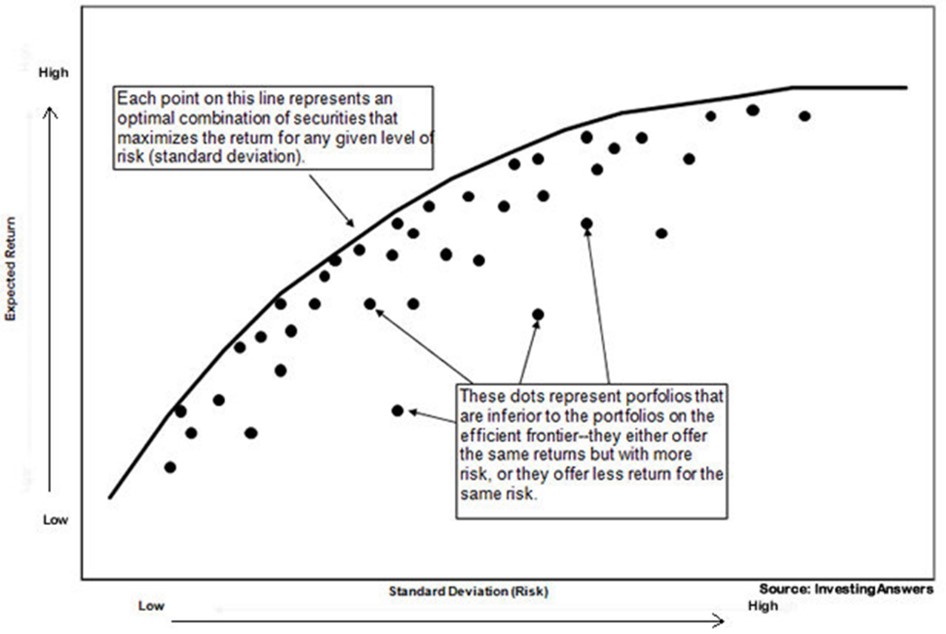
4% Rule Applicability
5/7/24
The “4% Rule” suggests that withdrawing 4% of your initial retirement portfolio balance annually, adjusted for inflation, should provide a sustainable income for at least 30 years. 4% was the largest withdrawal amount lasting throughout a 30-year retirement in William Bengen’s research. It worked for the worst historical case.
Later research by Micheal Kitces showed that in 2/3rd of cases dating back to 1870, the retiree would finish a 30-yr retirement period with more than double their starting principle if they followed the 4% rule.
Bengen didn’t intend his 4% SAFEMAX to become the 4% rule. The median successful withdrawal rate is closer to 6.5%. Today there are better ways to determine how much to save for a secure retirement.
Treasury Bills, Notes, and Bonds
4/30/24
Treasury Bills (T-bills), Treasury Notes (T-notes), and Treasury Bonds (T-bonds) are all types of debt securities issued by the U.S. Department of the Treasury to raise funds for government operations.
- Treasury Bills (T-bills): short-term debt securities with maturities typically ranging from a few days to one year. They are sold at a discount to their face value, and investors receive the face value at maturity, effectively earning interest as the difference.
- Treasury Notes (T-notes): intermediate-term maturities, usually ranging from 2 to 10 years. They pay a fixed interest rate (coupon) every six months until maturity, in addition to the face value returned at maturity.
- Treasury Bonds (T-bonds): maturities typically ranging from 10 to 30 years. Like T-notes, they pay fixed interest every six months, but their longer maturity means they provide more risk/reward.
Treasury securities are considered among the safest investments globally because they are backed by the full faith and credit of the U.S. government.
S&P Global Persistence Score
4/23/24
Relatively few actively managed funds outperform passive indexes over longer time periods. However, among funds that do outperform, how can we tell whether it is the product of skill or merely the result of good luck? This is the exact question S&P Global’s Persistence Scorecard addresses. They suggest that results produced by genuine skill are likely to persist while those due to luck are unlikely to persist.
Their year-end 2022 report “finds little evidence of persistent active management success, despite considering a variety of metrics and lookback periods. Exhibit 1 illustrates the general point, using 10 years of return data for U.S. equity managers.” In fact, past performance seemed to be less predictive than random luck.
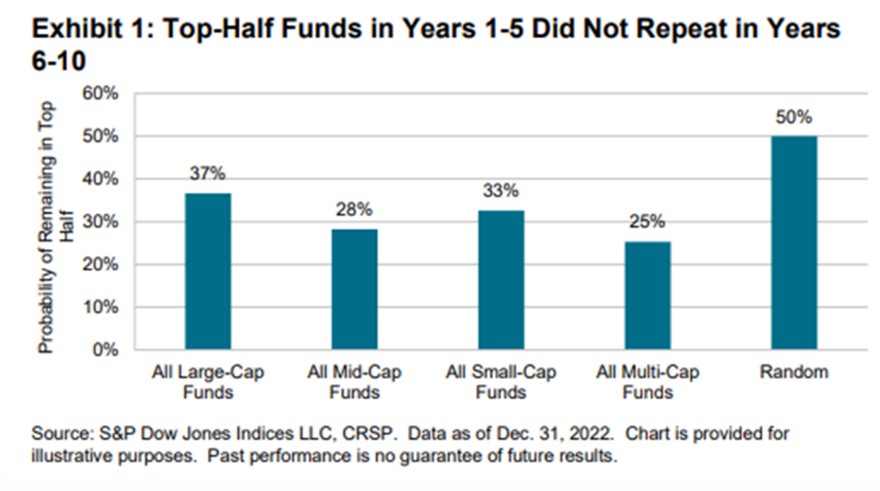
S&P Global’s SPIVA Scorecard
4/16/24
S&P Global’s SPIVA Scorecard measures actively managed funds against their index benchmarks worldwide. They offer scorecards for Australia, Canada, Europe, India, Japan, Latin America, the Middle East, South Africa, and the United States. The SPIVA research tells us that relatively few active managers outperform passive managers over any given time period. The odds of actively managed funds outperforming tend to drop with longer time periods.
The primary reason: actively managed funds have higher fees (expense ratios), and those fees erode investor returns. Fees matter!
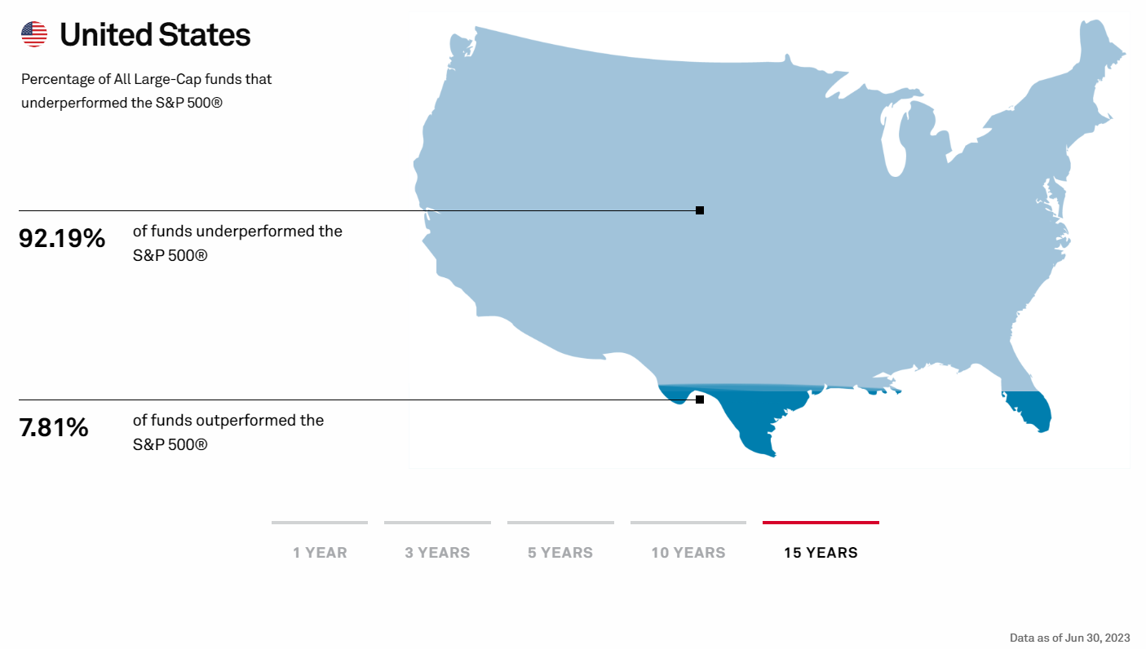
Health Savings Accounts
4/9/24
A Health Savings Account (HSA) is a tax-advantaged investment account designed for medical expenses. It offers quadruple tax-free benefits: tax-deductible contributions, tax-free growth, tax-free withdrawals, and potential FICA tax avoidance. HSAs are the most tax-advantaged account, and therefore one of the most powerful. Funding an HSA is generally ranked second in funding priority, only after getting an employer 401(k) match. For a family in the 22% tax bracket funding an HSA can reduce federal taxes by up to $2,460/yr.
HSAs are only available to those participating in a high deductible medical plan. Despite a common belief to the contrary, high deductible plans typically result in substantial savings relative to traditional low deductible plans.
To make maximum use of the HSA’s growth benefits one can use it as a supercharged retirement account. Withdrawals must be for qualified medical expenses, but do not have to be in the year of the expense. Receipts/EOBs can be saved to justify withdrawals decades later in retirement when funds are needed. This strategy gives HSAs maximum time to grow completely tax-free.
The Psychology of Money
4/2/24
“The Psychology of Money” by Morgan Housel is an incredible book that can transform the way you think about money. Money is a very emotional topic, and we all have psychological behaviors regarding money. Our behaviors around money are often based on our experiences and since life experiences can vary dramatically, so do our views and behaviors regarding money.
The book is certainly a worthwhile read for all but might be even more valuable for couples with differing money views. The book is a collection of money truths that bring awareness to many things we take for granted. It’s thought provoking, a genuinely interesting read, and can lead to valuable discussion and understanding.
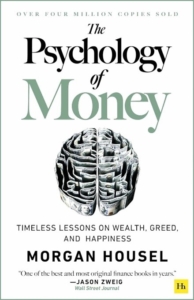
Gift Taxes
3/26/24
Do I have to pay taxes on gifts received? No. Gift taxes, if applicable, are always the responsibility of the donor, not the donee.
Gift taxes by the donor are rarely applicable due to annual and lifetime exclusions. A donor may give gifts, transfer tax-free, up to $18,000 per donee per year (2024). This exemption is doubled if gifting from a couple or to a couple ($18k from/to each person). Any gifts above the yearly exemption are subtracted from the lifetime exemption, currently $13,610,000 per person. Gift taxes by the donor are applicable only after this $13.61 million exemption is exhausted.
Corporate Profits
3/19/24
Companies generate profits, and those profits ultimately flow to the owners. A well-known chemical company reported $6.59 billion operating EBIT (earnings before interest and taxes) and 37,800 employees in their 2022 annual report.
$6,590,000,000/37,800 = $174,339 operating EBIT/employee
That is a significant EBIT per employee. If an employee has similar compensation (salary + benefits), one could consider equal parts of this employee’s contributions going to compensation and to ownership. This may not seem fair to some, but it’s our economic system. Rather than debate or complain, let’s act strategically.
There’s a saying, “if you can’t beat them, join them” and employees can join them. By participating in 401(k) and other investment opportunities, employees can slowly but steadily accumulate ownership of public companies and reap profits that flow to ownership. This is the simple key to building wealth.
Historical Returns of Stocks and Bonds
3/12/24
What are historical stock and bond returns? These are plots of the S&P 500 and 10-Year Treasury Bonds 1928-2022. The S&P 500 averaged 9.6%/yr with a 19.5% standard deviation. 10-year bonds averaged 4.6%/yr with an 8.0% standard deviation. Stocks had higher growth. Bonds were more predictable. Both play a role in constructing a well-balanced, diversified portfolio.
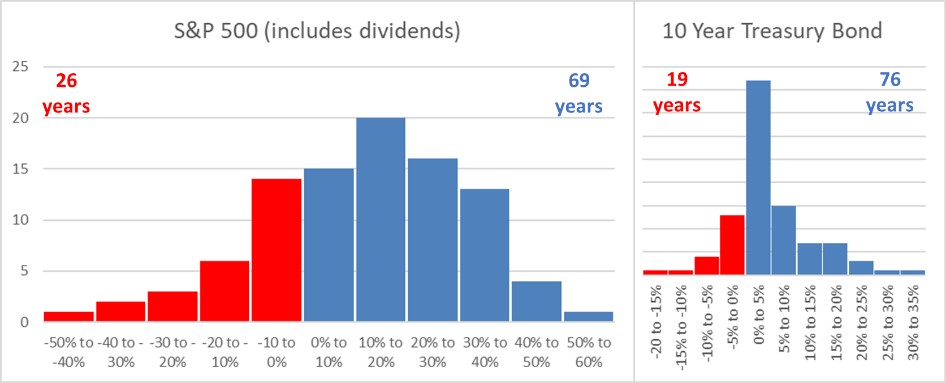
How Much Money Do I Need for Retirement
3/5/24
How much money do I need for retirement? The answer is really a personal choice. However, keep in mind that many expenses you have today may disappear. If you have kids, they’ll likely be out of the house. Daycare, food, clothes, activities, car expenses, etc. related to your kids may be gone. Mortgages may be paid off. Work related expenses disappear. As your spending decreases, taxes can drop dramatically (yay marginal rates). 7.65% FICA taxes are gone.
There are several rules of thumb on the internet suggesting an appropriate retirement nest egg, but they vary dramatically and overlook the most important aspect – individual circumstances. Financial planning is the most reliable way to quantify your future needs. In addition, financial planning ensures you reach your goals efficiently.
Financial Planning Software (eMoney)
2/27/24
Financial planning software has become a valuable tool for financial planners to model financial scenarios. Scientific Financial utilizes eMoney to organize a client’s financial assets and develop financial plans. eMoney uses a cash flow model to evaluate income, expenses, investment returns, tax liability, etc. on a year-by-year basis. It can also incorporate uncertainty with its Monte Carlo capabilities.
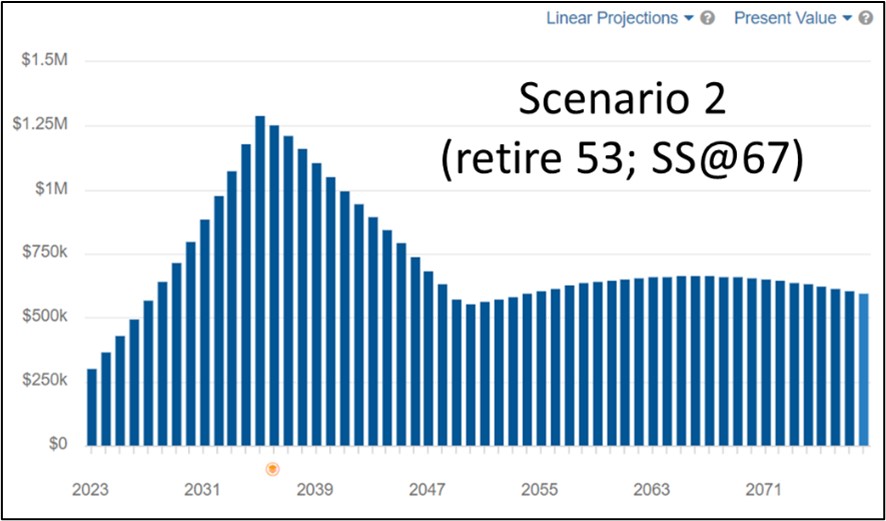
Financial planning software does not accomplish the most valuable part of financial planning – identifying opportunities. That value is dictated by the advisor’s knowledge. However, financial planning software does allow for the exploration and quantification of potential scenarios. This can be very valuable for a client to understand tradeoffs before selecting an action plan that best fits their values and preferred future life.
Commonly Missed Tax Reduction – Qualified Dividends
2/20/24
Possibly the most missed tax reduction relates to qualified dividends, 3a on the 1040. Tax software and financial statements often lead the taxpayer to leave box 3a blank. The IRS also shares blame as the 1040 form is misleading. Ordinary dividends (3b) are the total of all dividends reported on a 1099-DIV form. Qualified dividends (3a) are all or a portion of the ordinary dividends. They’re reported in box 1a on Form 1099-DIV. Qualified dividends are taxed at capital gains rates (often 15%). Non-qualified dividends (box 3b – box 3a) are taxed as ordinary income (often 22-24% marginal rate). For most investors, the vast majority of dividends are qualified dividends so be sure to report them in box 3a to ensure you pay the lower tax rate.
Don’t donate to Uncle Sam by leaving box 3a blank.

Asset Location
2/13/24
You may have an appropriately balanced investment portfolio, but have you considered asset location? Asset location focuses on where you hold particular investments. Roth IRAs are best suited for high growth assets (stocks). A pre-tax 401(k) is well-suited for lower growth assets (bonds) since this account will incur future taxes. The entirety will be taxed as ordinary income, not capital gains. In taxable accounts, consider investments with lower tax implications, like tax-efficient index funds.
The total stock/bond portfolio remains unchanged, but assets can be thoughtfully placed in accounts which will minimize your lifetime tax bill. Be strategic and avoid paying extra money to Uncle Sam.
Will I Pay Estate Taxes?
2/6/24
Will I/my parents pay federal estate taxes? Estate taxes are often misunderstood among the public. The 2024 federal estate tax exemption is $13.61 million per person. That’s $27.22 million for a couple. Essentially that means when the second to die of couple passes assets to the next generation, estate taxes only apply to the amount above $27.22 million. In 2020, <0.1% of people paid federal estate taxes. Heirs who receive an inheritance pay no taxes. The federal estate tax is pretty forgiving.
State estate taxes are a mixed bag. Oregon has the lowest exemption at $1 million per person. Most states (33 including Texas and Michigan) have no estate tax.
Index Funds vs Active Management
1/30/24
Index funds aim to replicate the performance of a specific market index, like the S&P 500, with very low fees. They provide broad market exposure. On the other hand, active management involves fund managers individually selecting investments in an attempt to outperform the market. While some active funds succeed, the vast majority underperform over longer time periods.
SPIVA monitors actively managed funds against their (proper) benchmark and provides scorecards to help investors understand returns of index funds vs actively managed funds. (Spoiler: about 92% of large cap funds underperformed the S&P 500 index 2008-2023)
Advantages of Investing Today
1/23/24
It’s easy to be pessimistic, but today we have significant investing advantages versus our parents.
- Low investing fees: In the 1970’s mutual funds often charged 1% or more expense ratios. Front-end or back-end loads of 5% were not uncommon. Today investors can get funds with fees below 0.1%.
- Accessibility: Today we have computers. That’s increased our options. The creation of an index fund with 4000+ companies is trivial and now very inexpensive. We can get incredible diversification and buy/sell ourselves. Many of our parents used a newspaper to check stock prices.
- Taxes: In 1979 the maximum personal tax rate was 70% and capital gains could be as high as 35%. Today, those max rates are 37% and 20%. You’re not likely in the top tax rate, but taxes are generally lower today.
- Tax-advantaged accounts: The 401(k) originated in 1978. The Roth IRA originated in 1997. And the most efficient investing account, the HSA, started in 2004. These 3 tax-advantaged accounts provide huge advantages to today’s investors.
Let’s be thankful for the investing advantages we have today. Many of our parents had to work until 60+. Today that’s not the case for the vast majority of us who engage in financial planning.
Medical Insurance Payment Terms
1/16/24
Health insurance has several important terms to understand. Premiums are paid on a regular basis and vary based on factors such as the type of plan, coverage level, etc. A health insurance deductible is the predetermined amount an individual must pay out of their own pocket before their insurance coverage begins to cover eligible medical expenses. Plans typically have co-insurance or co-pays. Co-insurance is the percentage of medical costs that an individual is responsible for paying after they’ve reached their deductible (ex: 20%). Co-pays are fixed amounts that individuals pay for specific medical services (ex: $100). The maximum out-of-pocket refers to the highest amount an individual is required to pay for covered medical expenses within a specific period, usually a year. This includes deductibles, co-insurance, and co-pays (but not premiums). The combination of these terms determines the value of the insurance, and the relative importance can vary by family.
Market Timing
1/09/24
Market timing refers to the practice of trying to predict the future movements of financial markets, such as stocks or bonds, in order to buy or sell assets at what is believed to be the most advantageous time.
To successfully time the market an investor must make two correct decisions, when to buy and when to sell. Research has shown that investors are rarely successful at market timing. The market is moving upward much more often than downward so any period of time with money on the sidelines is likely to miss gains.
Scientific Financial does not encourage market timing. We agree with the saying “Time in the Market beats Timing the Market”.
Financial Checkup
1/02/24
A financial checkup can be the financial equivalent to a medical checkup. Many of us schedule annual physicals and blood work to provide expert advice on our health and identify concerns before they become major problems. There’s also a benefit of obtaining expert advice on our financial life and identifying concerns before they become major problems.
Financial checkups are not common in the financial planning industry. Comprehensive financial planning can seem expensive, and price can become a barrier to those who don’t yet fully appreciate the value of financial planning. Financial checkups provide a lower cost entry point to financial planning.
Scientific Financial offers financial checkups as a 90-minute meeting to explore your financial picture and identify opportunities for improvement. It’s not comprehensive financial planning, but it’s much better than no financial planning.
Behavior Finance Biases – Anchoring
12/26/23
Behavioral finance bias refers to how psychological biases influence financial decisions. One common behavioral finance bias is anchoring. If the stock of a company has fallen quickly in a short period of time, some investors may anchor on a recent high, believing the price drop provides the opportunity to buy the stock at a discount and that the stock price will return to the previous value.
What is a Bond Fund?
12/19/23
A bond fund is an investment vehicle that pools money from multiple investors to purchase a diversified portfolio of bonds. These funds can hold various types of bonds, including government, corporate, municipal, or other fixed-income securities. Bond mutual funds or Bond ETFs (Exchange-Traded Fund) are often used to fill the bond allocation of an investor’s portfolio, thus reducing the volatility of the portfolio. It’s important to note that the value of bond funds can fluctuate with changes in interest rates and credit quality, so they have their own set of considerations in a well-rounded investment strategy.
The largest market cap bond fund holds approximately 10,707 bonds (12/4/23) and is available as a mutual fund (VBTLX) or an ETF (BND).
Complexity for the Sake of Job Security
12/12/23
If a financial advisor does complex things that you don’t fully understand, it’s possible they’re creating complexity for the sake of job security. A good financial planner makes investing simple. They seek to increase your understanding. They earn dedicated clients through creating value, not complexity and dependence.
Investment portfolios should not be complex. Owning more than 7-8 funds is probably not a good thing. Most families should not be utilizing complex tax-loss harvesting or direct index strategies. Options, alternative investments, hedge funds, and venture capital investments rarely outperform the simplest investing strategies.
If you have a financial advisor utilizing complex investing strategies or you’ve been a DIY investor and your investments have gotten complex, you may want to seek a free, second opinion from a fiduciary, fee-only financial planner. Recall the proverb “A fool and his money are soon parted.” Good investing is very simple.
Insurance Marketplace Subsidies
12/05/23
The Healthcare Marketplace resulted from the Affordable Care Act. The law provides consumers with subsidies (“premium tax credits”) that lower costs for households with incomes between 100% and 400% of the federal poverty level. These subsidies can be substantial and reduce the “health insurance problem” for those who choose to retire early or work independently.
Example: A 42-year-old couple with 3 young kids in Texas, with $100k income, could receive a subsidy of approximately $1,285 per month (2023). This can cover the entire premium of some Bronze plans.
Takeaway: The healthcare marketplace can substantially help with health insurance for those looking to work independently or retire early. You don’t have to work until you’re 65 and Medicare eligible.
How Do Assets Pass Upon Death
11/28/23
How do assets pass upon death? Generally, there are 4 methods to transfer assets.
- Contract titling – some assets may have a transfer on death (TOD), joint tenants with rights of survivorship (JTWROS) or other titling to shift ownership upon a death.
- Designated beneficiary – insurance policies and investment accounts typically have beneficiary designations.
- Trust – a legal contract between the grantor and a trustee. The trustee holds assets transferred to the trust for certain specified beneficiaries. The terms of the trust dictate what will happen upon the death of the grantor.
- Will – controls only those assets not passed through the methods above. Wills pass through probate, a legal process to distribute the remainder of the deceased’s estate.
Housing Ratios
11/21/23
Housing ratios are financial metrics used to assess the affordability of housing costs in relation to your income. Two common ratios are:
Housing Ratio 1 (Basic): This ratio is the percentage of your gross monthly income that goes toward housing expenses: payment on principal, interest, taxes, and insurance (PITI). Generally, a HR1 of 28% or less qualifies for a conforming (best) rate mortgage.

Housing Ratio 2 (Broad): This ratio considers the percentage of your gross monthly income that goes toward all debt obligations. The HR2 benchmark generally used by lenders is ≤36% of gross pay.
![]()
One can use these ratios to avoid being “house-rich, cash-poor”.
529 Plans
11/14/23
A 529 plan is a tax-advantaged savings account designed to help you save for education expenses. These plans are typically sponsored by states and some states offer tax deductions/credits for contributing to their 529 plan. Earnings in a 529 plan grow tax-free, and withdrawals for qualified education expenses are also tax-free. It’s a useful tool to utilize in educational funding strategies.
Term vs Whole Life Insurance
11/7/23
Life insurance can seem complicated, but it doesn’t have to be. There are two main types of life insurance:
Term Life: Term is the life insurance most naturally think of. It pays a death benefit in the event of an untimely death. Term life insurance is valid for a term – potentially 1 year, 10 years, 30 years. It’s generally an inexpensive way to protect one’s family when additional money is needed to provide for future plans (pay mortgage, college tuition, child expenses, support a stay-at-home spouse, etc.). Term life insurance is typically not needed in retirement.
Whole Life: Whole life insurance is permanent life insurance combined with investments. These products are generally expensive, high commission products with surrender fees for early cancelation. Whole life insurance is generally not appropriate for a typical family. Whole life policies can make sense for businesses and estate planning for the wealthy.
Higher Taxes from Pre-Tax 401(k) or Post-Tax Roth IRA
10/31/23
Will I pay higher taxes investing pre-tax in a 401(k) or post-tax in a Roth IRA? Assuming tax rates are the same, you’ll receive the same amount of money in either case. If you invest pre-tax, you’ll invest a larger amount. It’ll grow larger over time and incur a larger tax bill. However, the take home amount will be the same as paying income tax upfront, starting with a smaller investment, and avoiding future taxes. If you start with 25% less seeds, you get 25% less apples.
The decision to invest pre-tax vs post-tax has more to do with providing tax-efficient future cash flow options and future tax rate changes (federal changes and your bracket changes).
Dividends
10/24/23
Dividends are payments made by a corporation to its shareholders as a distribution of profits. They are typically paid in cash. Companies that generate profits may choose to distribute a portion of those earnings to their shareholders as dividends. Dividends can provide investors with a regular income stream. A company’s dividend history can indicate financial stability and a commitment to returning value to shareholders.
It’s important to consider dividends when looking at historical stock prices. Established companies may have large dividends (Dow’s dividend yield is 5.57% as of 9/22/23). Rapidly growing companies may have no dividends. Tesla, Amazon, and Alphabet/Google have no dividends in 2023. They prefer to reinvest those dollars internally rather than distributing cash to shareholders. Due to dividends a more established company may provide a higher investor return despite significantly less stock appreciation.
How Financial Advisors Charge
10/17/23
Financial advisors typically charge fees in a few common ways. One approach is an assets-under-management (AUM) fee, where a percentage of the total value of your investments managed by the advisor is charged. Another method is a flat fee, where you pay a fixed amount for specific financial services. Some advisors charge hourly fees based on the time they spend working with you. Additionally, there are commission-based fees where some advisors earn a percentage from the financial products they recommend.
Terms like fee-only and fee-based can help guide consumers but aren’t well understood. Some advisors transparently display fees on their websites (unfortunately most don’t). Many don’t appreciate the fees they pay under AUM and commission-based models since the fees are “hidden”.
Be empowered and know your fees. No advisor should ever be offended by explaining how they’re paid. If you don’t get a crystal-clear answer, that’s a bad sign. Be empowered. You’re in charge!
Estate Planning Documents
10/10/23
Estate planning documents allow you to manage your assets and wishes effectively. Key documents include:
- Will – Specifies asset distribution and appoints guardians for minor children.
- Durable Power of Attorney: Authorizes someone to make financial decisions if you’re incapacitated.
- Healthcare Power of Attorney: Allows a chosen individual to make medical decisions on your behalf.
- Living Will (Advance Healthcare Directive): States your medical treatment preferences in critical situations.
- HIPAA Authorization: Permits access to your medical information for designated individuals.
- Letter of Instruction: Provides guidance on funeral arrangements and your wishes to help guide those making decisions after your death. This is an informal document and not legally binding.
Items 1-5 are often included in a documents package provided by an estate lawyer. Dow’s benefit plan can pay 100% of these legal fees.
Behavior Gap
10/03/23
The behavior gap refers to the gap between an individual’s investment returns and the actual market returns. It often stems from emotional decision-making, like buying or selling investments based on fear or greed rather than a well-thought-out strategy.
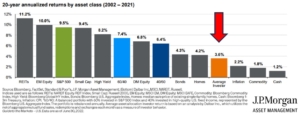
Dow’s 401(k) Options
9/26/23
Dow’s 401(k) offers many attractive investment options. Fees are generally very low. Investment options are grouped into 3 tiers: Target Date Funds, Core Funds, and Additional Funds (as of 2023).
Target Date Funds are available in 5-year increments. BTC LifePath® 2045 is designed for someone retiring around 2045. These funds invest aggressively when the target date is far away and shift more conservatively over time.
Core Funds include broad-based index funds. Options include an S&P 500 index, a completion index (total US index excluding the S&P 500), an international index, and a bond index fund.
Additional Funds include specialized indexes and active mutual funds.
Wash Sales
9/19/23
A wash sale occurs when an investor sells a security at a loss and then repurchases the same or a substantially identical security within a short period, typically within 30 days. The IRS disallows the immediate recognition of the loss for tax purposes in wash sales. Instead, the disallowed loss is added to the basis of the repurchased security. Understanding wash sale rules is essential for optimizing tax strategies when managing investment positions. Seeking professional advice can ensure compliance and informed decision-making.
Retirement Accounts Before 59.5
9/12/23
Generally, you can’t access retirement accounts before age 59 ½ without incurring a 10% penalty. However, there are several ways to avoid the 10% penalty for those planning to retire before 59 ½.
- Rule of 55
- Roth Conversion Ladders
- Substantially Equal Periodic Payments (SEPP)
With proper planning, retirement accounts can be accessed whenever you need them, regardless of age.
What to Invest In? (Accounts)
9/05/23
The US tax code provides us with several tax advantaged ways to invest money. Proper use of tax-advantaged accounts can make a huge difference to your wealth. Below is one general priority guide to place your money. Your personal situation may shift the order. There’s also value in balancing accounts with different tax treatments. Consult a financial planner for personalized advice.
1. 401(k) – Up to the employer match
2. Pay off high interest credit cards (not an account but typically higher priority than investing)
3. Health Savings Account (HSA) – can be an extremely powerful retirement account
4. 401(k) Pretax beyond employer match
5. Roth IRA
6. 401(k) Post Tax Contributions (if available; mega-backdoor)
7. Taxable Accounts
I Bond Off Ramp
8/29/23
I Bonds were all the rage in 2021 and 2022, but you may want to consider selling them soon. The current rate is 3.38%, lower than the 4.15% in my American Express Savings Account.
I Bonds must be held for 12 full months and then there is a 3-month interest penalty on I Bonds held for less than 5 years. Get this wrong and you could lose 3 months of 6.48% interest, rather than the current 3.38%. A good strategy is to wait 3 months after the 6.48% rate has been completed, then redeem early in the next month. That way all the penalty will apply to the 3.38% rate. However, when your 6.48% rate ends/ended depends on the month you bought them. Some can sell now, but others may need to wait several months to ensure they only forfeit the 3.38% rate. Several online articles can be found to explain the nuance.
Marginal Tax Rates
8/22/23
Marginal tax rates apply to the last dollar of your income within a specific tax bracket. As your income increases, you might move into higher tax brackets, leading to a higher marginal tax rate for those additional earnings. It’s important to note that the marginal tax rate isn’t applied to your entire income, only the portion within that bracket. An understanding of marginal tax rates will help you reduce lifetime taxes and understand when pre-tax and post-tax investments are more efficient.
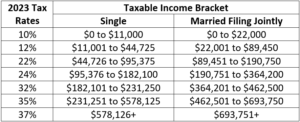
Target Date Funds
8/16/23
Target date funds are investment funds designed to simplify retirement planning. They automatically adjust the asset allocation mix (stocks, bonds, etc.) based on your target retirement year. When retirement is further away, the fund may have a higher stock allocation for potential growth. As you near retirement, the allocation shifts towards more conservative assets to preserve capital. Target date funds offer convenience, are generally well diversified, and often available with reasonable expense ratios. Asset location and tax efficiency should be considered when considering target date funds.
Expense Ratios
8/7/23
Mutual funds and ETFs have an expense ratio which is a management fee for the fund. You may not see the bill, but you’re paying it, and it may be significant. Below are examples of two popular Fidelity funds.


